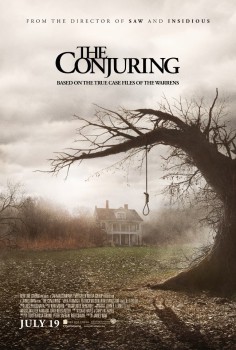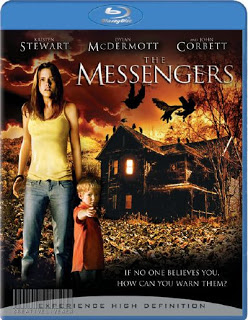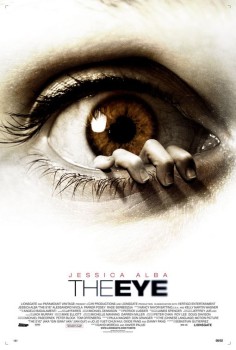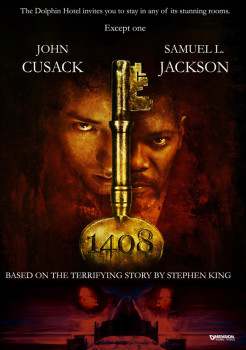Weird of Oz Conjures Up Some Other Horrors
 This week, I’m going to take a break from the summer heat and my blogging of Arak, Son of Thunder to get all spooky on you. This is a topic I’d normally tackle in the autumn, closer to Hallowe’en, but it turns out that one of the surprise summer hits is a supernatural horror film called The Conjuring. If you enjoyed that film and are looking for some home-viewing follow-ups, here are a few to consider…
This week, I’m going to take a break from the summer heat and my blogging of Arak, Son of Thunder to get all spooky on you. This is a topic I’d normally tackle in the autumn, closer to Hallowe’en, but it turns out that one of the surprise summer hits is a supernatural horror film called The Conjuring. If you enjoyed that film and are looking for some home-viewing follow-ups, here are a few to consider…
The Messengers (2007)
As the movie poster for The Messengers tells us, “There is evidence to suggest that children are highly susceptible to paranormal phenomena.”
One thing’s for certain: the children in this film certainly are.
A few years ago, I saw a subtitled edition of The Eye, the movie that put Hong Kong co-directors (and twin brothers) Danny and Oxide Pang on the American map, and it did induce chills. Here, as in that earlier film, the Pangs demonstrate their skill at evoking the dread of The Thing You Must Not See: you know something is behind you, but you can’t turn and look because what you’d see might make your heart freeze.
In their first American film, the Pangs go rural with heartland gothic horror. The Solomon family has moved from Chicago to make a go of raising sunflowers on a North Dakota farm. The weathered old farmhouse is creepy even without the ominous sounds and the claw marks on the floor outside the basement door.
 There are odd occurrences. Dad (Dylan McDermott) is attacked by a murder of crows. A moldy stain on the wall keeps coming back bigger each time Mom (Penelope Ann Miller) cleans it — that’s always a bad sign. But only thirteen-year-old daughter Jess (Kristen Stewart) and little brother Ben, who doesn’t talk, can see that the house, the barn, and the fields are crawling with ghosts…very disturbing ghosts that scuttle up walls and across ceilings like spiders in weird time. And when Jess tries to tell her parents and the long-haired hired hand (John Burwell) what she’s experienced, the adults don’t believe her.
There are odd occurrences. Dad (Dylan McDermott) is attacked by a murder of crows. A moldy stain on the wall keeps coming back bigger each time Mom (Penelope Ann Miller) cleans it — that’s always a bad sign. But only thirteen-year-old daughter Jess (Kristen Stewart) and little brother Ben, who doesn’t talk, can see that the house, the barn, and the fields are crawling with ghosts…very disturbing ghosts that scuttle up walls and across ceilings like spiders in weird time. And when Jess tries to tell her parents and the long-haired hired hand (John Burwell) what she’s experienced, the adults don’t believe her.
Stewart creates a sympathetic character who has to confront the house’s horrors completely isolated by her parents’ disbelief. The Solomons will find out soon enough that they should have put a little more trust in their daughter.
The film’s third act introduces a threat of a more prosaic nature: homicidal maniac with pitchfork. I won’t say any more on that so as not to give away key plot points. But it is refreshing that the ghosts are scarier than the raving lunatic.
After seeing a movie, I usually give it a day or two before assigning a rating. Some movies linger; they grow in the memory. Others are suspenseful and engaging in the moment, but prove largely forgettable once the ride is over. This is a sure sign that the underlying story is thin, that the movie was mostly surface. The Messengers features a spooky house with great atmosphere and some genuinely frightening scenes, but it is not one that has continued to haunt me when I think of it days or months or years later, unlike The Haunting (the 1963 version) or The Changeling (1980) or Dead End (2003).
In retrospect, The Messengers mostly reminds me of other movies, as if it were composed of bits and pieces borrowed from horror classics. Do I recommend it? Good haunted house movies come along all too rarely, so if you’re looking for that special eeriness that only creaking floorboards and creepy basements can deliver, this one dishes out such moments. Just don’t expect to be haunted by it the next day.
The Eye (2008)
 Don’t keep your popcorn on your lap during The Eye. It’ll wind up all over the couch.
Don’t keep your popcorn on your lap during The Eye. It’ll wind up all over the couch.
As a rule, I’m annoyed by spring-loaded cats (when a director plants a false scare like the ubiquitous cat jumping from a closet, accompanied by a sudden spike in the soundtrack that would make anyone but a deaf person jump). Jump-scares seem to be more prevalent in this trend of “PG-13” horror, almost certainly because it’s a way to scare young audiences and send them into titters without introducing material that could jeopardize the rating. It’s a cheap tactic and forgotten by the next scene. It’s also a sign that the director might not know how to generate real frisson and genuine terror.
All that said, there are numerous jump-scares throughout The Eye, a remake by directors David Moreau and Xavier Palud of a Hong Kong film, and many of them are quite effective (though not always as effective as in the Pang brothers’ 2002 original). More important, they are not false scares — no spring-loaded cats. They are delivered by ghosts that suddenly appear, and the ghosts have a reason in the story for being there.
The reason is a corneal transplant. Concert violinist Sydney Wells (Jessica Alba) has been blind since a firecracker accident when she was five years old. Now she can see again, but her new eyes see dead people — and that’s not all. They also see demonic beings who are always inexplicably on hand to lead newly-departed spirits away to — who knows where, but I hope the deceased don’t have to spend their afterlife looking at those guys. The new eyes also impart other clairvoyant powers, as Sydney begins seeing both events that happened in the past and events that may happen in the future. Soon Sydney is on a quest to find out who the donor was, perhaps thereby finding the key to her creepy peepers. To give much more information than that would threaten spoilers.
One observation many critics have made about American remakes of foreign horror films is that, whereas Asian filmmakers are content to maintain an air of mystery, leaving supernatural events in the realm of the unexplained, American filmmakers feel a need to bring western logic to the events — a bone to the scientific-reductionist worldview. Everything has a cause and follows laws that can be discovered and defined. Thus, in this version scriptwriter Sebastian Gutierrez (who also wrote Snakes on a Plane!) gives us some stuff about “cellular memory.” I have no problem with this: it is a logical place for Alba’s character to go in trying to explain what’s happening to her. She’s trying to convince her eye therapist (Alessandro Nivola) that she’s not crazy.
But introducing such scientific rationales into these movies is a two-edged sword: once you suggest answers and supply motives for events, the aspects that defy logic stand out in sharp contrast and raise all sorts of new questions. For instance, with her new corneas Sydney can now see ghosts, but she didn’t get ear transplants: why can she also hear them? And since newly-departed spirits are immediately escorted away by the creepy, anorexic shadow beings, what is the ghost of the boy in her apartment building doing still hanging around? Did he get overlooked? I wonder, because the guys with scary teeth seem very efficient — they even show up moments before a person is about to die, demonstrating a dedicated work ethic.
When this film came out, it was the second time in four weeks that we had French directors on an American remake of an Asian original. Is this the new Axis of Horror? I hope not, because the end results have ranged from uneven (The Eye) to downright hokey (One Missed Call).
The filmmakers follow the original pretty closely. They deliver a story that is interesting both in its exploration of the unreliability of our senses and in its depiction of a woman struggling with horrific visions. The visions could either convince her she’s insane or, if they’re real, possibly drive her insane. Overall, we get acting that is passable but not noteworthy, an intriguing premise and fairly engaging storyline, and some scary scenes. One such chilling scene is the ghost in the elevator — it’s frightening here, but if you really want to be unnerved, see it in the original.
1408 (2007)
You can guess who speaks that bit of dialogue, since the cast includes Samuel L. Jackson. The room he’s describing is 1408 of the Dolphin Hotel.
Note that a classic, old-style building like the Dolphin does not have a thirteenth floor: floor 14 is, in fact, floor 13. And also note what 1+4+0+8 add up to. That’s all a bit of Stephen King having some fun.
When he wrote the novella “1408” (included in his collection Everything’s Eventual), I think King wanted to write the scariest haunted room story that he, the “modern master of horror,” could possibly muster. He partly succeeded, and the movie — being a pretty faithful adaptation — partly succeeds as well. The best part of the movie is also the best part of the story, and that is, in both cases, the buildup. The rest is a bit of a letdown, but the suspense of the buildup is worth it.
We are immediately introduced to Mike Enslin, played perfectly by John Cusack, a writer who has given up novels to make a buck writing ghost-hunting guides. As a paranormal investigator, he’s got all the gadgets and doo-dads for reading thermal prints and temperature fluxes and electromagnetic fields and such. He faithfully investigates the allegedly haunted rooms of every quaint bed-and-breakfast and hotel he stays in, but he doesn’t really expect to find anything. He is a skeptic and, ever since his young daughter died, an atheist. Yet we get the impression there is some small place in his cynical head that hopes — craves — to find some proof that death is not the end.
This is a King story, so we know that Mike is going to get his wish in spades — if he survives it.
He receives a mysterious postcard tipping him off to room 1408 of the Dolphin, a ritzy old hotel in Manhattan. When he calls to inquire about the room, he gets a reception he is not accustomed to. Most of the hotel and B&B owners he deals with welcome the free publicity he brings, but the manager of the Dolphin declines: room 1408 is most definitely off-limits.
Mike’s publisher calls in a lawyer and a fancy legal maneuver gets Mike a booking. But when he arrives for his overnight stay, the hotel manager, Gerald Olin (Samuel L. Jackson), is waiting for him.
And this is the best part of the movie: the showdown between Olin, who uses every ploy he can think of to dissuade the intrepid investigator, and Mike, whose interest only grows more piqued. Olin goes through the litany of suicides, which Mike already knows from his research. But then Olin throws him a wringer: “In your research, did you come across all the cases of guests who died of natural causes? Heart attacks, strokes… It brings the number to fifty-six.” You can almost see Mike’s ears prick up. You know he’s thinking, Could this be the real deal? He’s all the more anxious to get into the room, and the suspense for us, the audience, is palpable.
I love Olin’s description of the once-a-month cleaning of the room (though the room is no longer rented out, hotel policy demands that the room be dusted, the sheets turned up — the ghosts aren’t going to do it): the maids always go in pairs, with Olin himself waiting in the hall outside. “We treat the room as if it were filled with poison gas.” This generally works — except for the one maid who was only gone a few moments, got locked into the bathroom, and gouged her own eyes out. When they pulled her out, she was laughing hysterically.
This wonderfully tense conversation comprised something like thirty pages of the story, and it is great reading. It’s also the best reason to see the movie. But of course, the anticipation such a scene builds up is going to be very difficult to live up to. Director Mikael Hafstrom isn’t quite able to do it, though neither was King. The horrors the room throws at Mike are pretty generic — although the Carpenters song that keeps playing unexpectedly on the radio is a nice touch. Who knew “We’ve Only Just Begun” could induce chills?
When Cusack gets into the room, he becomes a one-man show, reacting to the ever-increasing intensity of the mindbenders the room throws at him — many of them dredged up from his own subconscious. It has its moments (the man in the window across the street is the best), and Cusack’s acting is first rate in carrying it off. But there is more psychological tension than outright scares.
Some people have described 1408 as a bargain-basement version of The Shining — instead of a haunted hotel, a haunted room. But like its predecessor, 1408 owes much to Shirley Jackson’s classic 1959 novel The Haunting of Hill House. It is not, as Olin warns, just a phantom haunting room 1408. Shirley Jackson described Hill House as “not sane.” Here, another Jackson describes room 1408 as f**king evil. They’re both getting at the same thing. These places are not haunted by traditional ghosts; rather, like Hill House, like The Overlook, room 1408 is itself a kind of living entity that seems to psychically feed on guests unlucky enough to enter its belly.
It is refreshing to see a horror film that goes for spookiness rather than torture and grue to generate its frisson. I hope we’ll see more like this — they’re all too rare.

I’ve had my interest peaked with all of the buzz and clips surrounding The Conjuring. I want to see it. Like you, I’m much more interested in chills than in gore.
In the movies you’ve reviewed, I’ve only seen 1408, which I wasn’t incredibly crazy about. I mainly watched it because I’m a big John Cusack fan.
What do you think of Ju-On (NOT The Grudge!) or the first Paranormal Activity? I think those movies do a really good job of providing true chills (or at least the first time you see them). I’m also a big fan of the original The Haunting. And, for what it’s worth, I think the scene of the home video of the birthday party in M. Night Shyamalan’s Signs is still pretty freaky.
James,
I think the first Paranormal Activity was very effective, the second one less so (I haven’t seen the subsequent ones). I agree about that scene in Signs–Shyamalan’s films, even the failed ones, are replete with such moments.
For me, too, the 1963 The Haunting remains the template. It’s one of my favorite films, period.
[…] Weird of Oz Conjures up Some Other Horrors […]